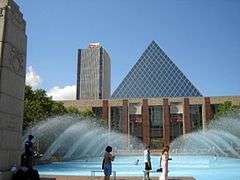Commonwealth Stadium (Edmonton)
 | |
 | |
| Location |
11000 Stadium Road Edmonton, Alberta, Canada |
|---|---|
| Coordinates | 53°33′35″N 113°28′34″W / 53.55972°N 113.47611°WCoordinates: 53°33′35″N 113°28′34″W / 53.55972°N 113.47611°W |
| Owner | City of Edmonton |
| Capacity |
42,500 (1978–1979) 43,346 (1980–1981) 59,912 (1982) 60,081 (1983–2007) 59,537 (2008–2012) 56,302 (2013–present) |
| Record attendance | 63,317 |
| Surface |
Grass (1978–2009) FieldTurf Duraspine Pro (2010–2015) GTR Turf/Shaw Sports Turf Powerblade Elite 2.5-S with Hydrochill system (2015–present) |
| Construction | |
| Opened | 1978 |
| Renovated | 2001, 2008 |
| Expanded | 1982, 2013 |
| Construction cost |
$20.9 million ($72.4 million in 2016 dollars[1]) Expansion: 1982: C$11 million ($25.4 million in 2016 dollars[1]) 2013: C$12 million ($12.4 million in 2016 dollars[1]) Renovations: 2001: $24 million ($31.1 million in 2016 dollars[1]) 2008: C$112 million ($124 million in 2016 dollars[1]) Total cost: $265.3 million in 2016 dollars |
| Architect | Bell, McCulloch, Spotowski and Associates |
| Tenants | |
|
Edmonton Eskimos (CFL) (1978–present) Edmonton Drillers (NASL) (1979–1981) FC Edmonton (CC) (2011–present, occasionally) | |
Commonwealth Stadium, also known as The Brick Field at Commonwealth Stadium during Eskimos events, is an open-air, all-seater multipurpose stadium located in the McCauley neighbourhood of the Canadian city of Edmonton, Alberta. Its main tenant is the Edmonton Eskimos of the Canadian Football League (CFL), although it is also used for athletics, soccer and rugby union, as well as concerts. The stadium has a seating capacity of 56,302, making it the largest in Canada. Construction commenced in 1975 and the venue opened ahead of the 1978 Commonwealth Games, replacing the adjacent Clarke Stadium as the Eskimos home. It received a major expansion ahead of the 1983 Summer Universiade, when it reached a capacity of 60,081. The stadium had remained, for a long time, the only CFL venue with natural grass, until FieldTurf Duraspine Pro was installed in 2010.
Events at the stadium include four Grey Cups, the CFL's championship game, and the 2001 World Championships in Athletics. Soccer tournaments include nine FIFA World Cup qualification matches with Canada Men's National Soccer Team, two versions of the invitational Canada Cup, the 1996 CONCACAF Men's Pre-Olympic Tournament, the 2002 FIFA U-19 Women's World Championship and the 2007 FIFA U-20 World Cup. FC Edmonton has since 2011 played its Canadian Championship matches at Commonwealth Stadium. The venue also hosted matches during the 2014 FIFA U-20 Women's World Cup and the 2015 FIFA Women's World Cup. In rugby, Commonwealth has hosted the 2006 Women's Rugby World Cup and three editions of the Churchill Cup. The stadium is also listed as a potential site for the 2026 FIFA World Cup, if Canada were to win the event.
History
The main stadium in Edmonton was Clarke Stadium, which opened in 1939 and was built on a 38-acre (15 ha) plot of land. Work on applying to host the 1978 Commonwealth Games started in the early 1970s. With both federal, provincial and city funding backing the bid, it called for a massive renovation of the city's various sporting venues. The original plans called for Clarke Stadium to be rebuilt and expanded to host the athletics events. By 1974 there was consensus that Clarke Stadium would not be sufficient and that an all-new stadium should be built. Several locations and sizes were discussed, with Edmonton City Council in January 1975 landing on building a 40,000 seat venue next to Clarke Stadium.[2] The venue was designed by Ragan, Bell, McManus Consultants.[3] The city also decided to build to additional new venues: Kinsmen Aquatic Centre and Argyll Velodrome.[2] They based their design on Jack Trice Stadium in the US city of Ames, Iowa.[4]
Part of the public support for the stadium came from it being built to also support being used by the Eskimos. The plans were met with opposition from local residents. There were also discussions regarding the necessity of a $50,000 royal retirement room and the allocation of training and office space to the Eskimos. The largest discussion was related to whether the stadium needed a roof or dome. As the roof would cost $18.2 million, there was limited public support and the stadium was built without one.[2] In an attempt to further the roof process, the Eskimos offered to pay $1.6 million towards the roof.[4] An enclosement would not be permitted used during the Commonwealth Games, so the design would have to call for the roof to be added afterwards. Among the opponents of the roof was Commonwealth Games Foundation President Maury Van Vilet, that experience from construction of the Olympic Stadium in Montreal showed the necessity of building a simple structure. An alternative design, which would have cost an additional $7.3 million, was launched by the Eskimos in August 1975, but rejected by the city council.[3] A major concern for the city council were the large cost overruns which were being experienced in Montreal at the time.[4]
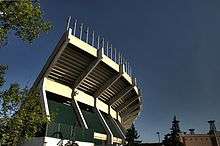
Excavation started in December 1974 and saw the removal of 400,000 cubic meters (500,000 cu. yd.) of earthwork. A local action committee, Action Edmonton, demanded in early 1975 that construction be halted and the venue relocated. The city estimated that this would cost an additional $2.5 million and delay the process with eight months.[4] The decision to not enclose the stadium was taken on December 10, 1975.[3] The venue was thus not designed to allow a roof, air-filled or stiff, to be retrofitted.[5] The venue was built on the former site of the Rat Creek Dump and the Williamson Slaughter House. During excavation, remains from the dump were struck, resulting in archaeological surveys being carried out.[4] Construction of the Edmonton Light Rail Transit's inaugural Capital Line commenced in 1974 and was opened in time for the Commonwealth Games, which allowed spectators to take the LRT from Stadium Station to downtown Edmonton.[6]
Construction of the stadium was completed within budget and time.[2] When the venue opened it had a capacity for 42,500 and a natural grass turf.[7] Unlike most other major stadiums in Canada, Commonwealth Stadium elected for a natural grass turf.[2] The original configuration included 39,384 bucket seats and 3,200 bench seating on the north end. The venue was officially opened on July 15, 1978 in an event which attracted 15,000 spectators.[4] The venue went through a slight expansion in 1980, when the seating capacity was increased to 43,346.[7] Additional proposals for a roof, ranging from $10 to $32 million in cost, were presented in 1979, but since then the discussion of covering the stadium died out.[4]
Edmonton was selected to host the 1983 Summer Universiade, and in 1981 the city council approved an $11 million upgrade to the venue, which added a further 18,000 seats to the upper tiers and the north end zone;[4] this gave a capacity of 59,912 in 1982 and 60,081 from 1983.[7] For special events, such as the Grey Cup, additional seating could be added. This made it the second-largest stadium in Canada, after Montreal's Olympic Stadium, and the largest without a dome.[2]
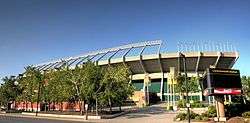
Ahead of the 2001 World Championships in Athletics, the stadium received a $24-million facelift. Major investments included a new facade, an enlargement of the concourse, improved lighting, a new scoreboard and an all-new all-weather running track.[4] Ahead of the 2008 season the stadium underwent a reconfiguration, reducing its capacity to 59,537.[7] For the nine seasons prior to 2010, the turf was replaced eight times, costing $50,000 per time.[8] The natural grass turf was replaced with FieldTurf Duraspine Pro in May 2010, making the Eskimos the last CFL team to switch to artificial turf [9], and the last team to play on grass until the Toronto Argonauts began playing at BMO Field. The investment cost $2.6 million and was split evenly between the city and the Eskimos.[8] The work included the removal of 12,400 cubic meters (440,000 cu ft) of soil,[9] and the turf has a life expectancy of 8 to 10 years. It will cost $500,000 to replace. The reason for the replacement was to reduce injuries, reduce the need for watering and fertilizer, will allow a green turf for the entire season, including at Grey Cups, will allow the venue to host more events, as concerts and the like will not damage the field, and that turf is recycled and recyclable.[8]
Commonwealth Stadium underwent a $112-million facelift starting in 2009. The main investment was a field house, new locker rooms, a hosting area and two floors of office space.[10] The complex, named the Commonwealth Community Recreation Center and designed by MacLennan Jaunkalns Miller Architects and HIP Architects, also consists of an aquatic center, a fitness center.[11] The complex was completed in February 2012.[12]
Following the 2010 Grey Cup, the program to replace the seating at the stadium commenced. All seating was replaced with new and wider seats, and the color changed from red and orange to green and yellow—the Eskimos' colors. Approval of the $12 million upgrade was made by the city council on May 18, 2011, and it took 11 months to select a supplier, with installation starting in June 2012. The upgrade removed all bench seating, which had been in place in the corners and end zones, resulting in an all-seater stadium. Because of wider seats, 48-centimeter (19 in) being replaced with 53-centimeter (21 in), capacity for the venue as reduced to 56,302. The process reduced the number of seats on rows by one.[13] With the seating installed, the total investment in the venue exceeded $200 million.[14]
On June 15, 2016, the Edmonton Eskimos announced a five-year field naming rights partnership with The Brick to name the field "The Brick Field at Commonwealth Stadium" during CFL events.
Facilities
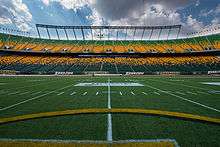
Commonwealth Stadium has a seating capacity of 56,302, in an all-seater configuration. The stadium has two twin-tier grandstands along each side, and single-tier stands on the corners and end zones. The sides feature 44,032 seats, with the remaining 12,386 in the corners and end zones. The side seats are 53 centimeters (21 in) wide and have a cup holder, a feature lacking on the narrower end zone seats. The seating is laid out in a colorized mosaic pattern, with dark "Eskimo" green at the bottom, yellow in the middle and lighter green at the top. In the sides there are 14,203 dark green seats, 19,019 yellow seats and 10,810 light green seats. In the corner and end zones there are 8,672 dark green and 3,713 yellow seats.[13] There are 15 executive suites on the east stand, 7 on the west stand and 8 on the south end zone. There is a limited amount of covered seating on the upper sections of the lower tier on the sides; half of this section on the east stand is a media center.[15]
The stadium has a FieldTurf Duraspine Pro artificial turf which covers an area of 10,215 square meters (109,950 sq ft). It contains additional cushioning through the installation of an extra shock pad.[9] The turf lacks permanent line markings; this allows the markings to alternate between football and soccer.[16] Because of the running track, the corners of the end zones were partially cut. In 2014, the end zones were squared off.[17] The track and field segment consists of a Sportflex Super X all-weather running track manufactured by Mondo of Italy. The International Association of Athletics Federations has certified the stadium as a Class 1 venue, a certification only two other stadiums have in Canada: Moncton Stadium and Université de Sherbrooke Stadium.[18]
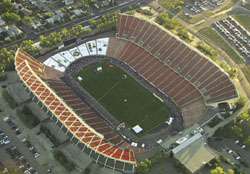
At the Commonwealth Stadium complex is the Field House, an 8,400 square meter (90,000 sq ft) three-story training facility which includes a running track, a 64-by-64-meter (70 by 70 yd) artificial turf training field, a fitness and weight room, locker rooms and a running track.[12] It is part of the Commonwealth Community Recreation Center, which also includes a 5,600 square meter (60,000 sq ft) aquatics center with a four-lane lap pool, water slides and a recreational pool; 2,800 square meters (30,000 sq ft) of administrative offices; and a 2,800 square meter (30,000 sq ft) fitness center. The building features a central lobby with each of the facilities in an annex. The center has Leadership in Energy and Environmental Design (LEED) Silver certification.[11] Adjacent to Commonwealth Stadium lays Clarke Stadium; it sits 5,000 and is both used as a training field and as the home ground of the North American Soccer League side FC Edmonton.[19]
The stadium is served by Stadium Station of the Edmonton Light Rail Transit's (LRT) Capital Line. During Eskimos games, the service frequency is increased. The City of Edmonton and the Eskimos cooperate on the Green & Go program, which provides free transit rides to the venue from six park and ride lots throughout Edmonton. Any holder of a pre-purchased ticket or an Edmonton Transit System ticket can travel for free on the services from these lots to Commonwealth Stadium. The program is initiated by the city to minimize parking and congestion in the stadium's neighborhood. Game day tickets are also valid fare on the LRT service from two hours prior to games to two hours after games. The city declares a neighbourhood parking ban in the vicinity of the stadium during games, with only cars with residential permits being allowed to be parked on streets.[20]
Events
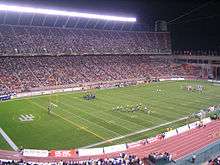
Athletics
Commonwealth Stadium was the centerpiece of the 1978 Commonwealth Games, which were hosted from August 3 to 12.The games saw 1,474 athletes from 46 nations competed in 128 events. Canada conducted its all-time best performance, capturing 45 gold medals and 109 medals in total. Commonwealth Stadium hosted the athletics events,[2] which consisted of 38 events: 23 for male and 15 for female competitors, as well as the opening and closing ceremonies.[2]
The success and popularity of the Commonwealth Games resulted in Edmonton bidding for and being selected to host the 1983 Summer Universiade. The Commonwealth Stadium was again selected to host the athletics events, in addition to the opening and closing ceremonies.[2] 24 male and 17 female athletics events were hosted. The games saw 2,400 participants from 73 countries, but did not attract the same public attention as the Commonwealth Games had.[2]
The 2001 World Championships in Athletics were held at Commonwealth Stadium between August 3 and 12, featuring 1677 participants from 189 nations.
Canadian football
Commonwealth Stadium has been the home of the Canadian Football League's Edmonton Eskimos since the 1978 season.[2] In the 1977 season, the last whole season at Clarke, the Eskimos drew an average 25,324 spectators, filling up the venue to its capacity for seven of eight games.[21] For the 1979 season, they drew an average 42,540 spectators, selling out seven of eight games.[22] The all-time regular-season attendance record is 62,517, set against the Saskatchewan Roughriders on September 26, 2009.[23] 28 regular-season Eskimos games at have sold out at Commonwealth. With the laying of artificial turf in 2010, the Eskimos stopped training on Clarke Stadium and have since used Commonwealth Stadium as their training ground.[24]
|
|
The stadium has been host to the Grey Cup, the CFL's championship game, four times, in 1984, 1997, 2002 and 2010. Tickets to the 2010 Grey Cup were sold out prior to the start of the season. The game was spectated by a crowd of 63,317, the largest to ever attend the stadium.[60]
| Game | Date | Winning team | Score | Losing team | Attendance |
|---|---|---|---|---|---|
| 72nd | November 18, 1984 | Winnipeg Blue Bombers (8) | 47–17 | Hamilton Tiger-Cats | 60,081 |
| 85th | November 16, 1997 | Toronto Argonauts (14) | 47–23 | Saskatchewan Roughriders | 60,431 |
| 90th | November 24, 2002 | Montreal Alouettes (5) | 25–16 | Edmonton Eskimos | 62,531 |
| 98th | November 28, 2010 | Montreal Alouettes (7) | 21–18 | Saskatchewan Roughriders | 63,317 |
Soccer
The Edmonton Drillers of the North American Soccer League, then the premier soccer league in Canada and the United States, was established in 1979 with the relocation of the Oakland Stompers. Bought by Peter Pocklington, the team chose to play its first three seasons at Commonwealth Stadium. The team played to home play-off matches during the 1980 season.[61] The Drillers averaged between 9,923 and 10,920 in their first three seasons.[26] After having lost $10.5 million in three years, Pocklington chose to relocate to Clarke Stadium for the 1982 season. This caused average attendance to plummet to 4,922 and the team was disbanded at the end of the year.[61]
Because of its former natural grass turf, Commonwealth Stadium has been a favored stadium for the Canadian Soccer Association to host national games. It has hosted 18 games of the Men's National Soccer Team and two of the Men's Under-20 National Team. The most intense period was between 1995 and 2000, when 13 A-team games were played. The A-team has played nine FIFA World Cup qualification and five friendly matches at Commonwealth. The record attendance of 51,936 was set when Canada tied Brazil 1–1 on June 5, 1994.[62]
The Canadian Soccer Association twice invited to the Canada Cup, a three- or four-way invitational international friendly tournament, with all matches hosted at Commonwealth Stadium. The 1995 Canada Cup featured Canada, Northern Ireland and Chile,[63] while the 1999 Canada Cup featured Canada U-23, Iran, Ecuador and Guatemala U-23.[64]
| Dates | Tournament | Opponent | Score | Attendance |
|---|---|---|---|---|
| September 27, 1980 | Friendly | | 3–0 | — |
| June 16, 1983 | Friendly | | 0–3 | 10,240 |
| July 25, 1984 | Friendly | | 0–0 | 6,137 |
| September 27, 1993 | 1994 FIFA World Cup qualification | | 2–1 | 27,775 |
| June 5, 1994 | Friendly | | 1–1 | 51,936 |
| May 22, 1995 | 1995 Canada Cup | | 2–0 | 12,112 |
| May 28, 1995 | 1995 Canada Cup | | 1–2 | 17,047 |
| August 30, 1996 | 1998 FIFA World Cup qualification | | 3–1 | 9,402 |
| October 10, 1996 | 1998 FIFA World Cup qualification | | 2–0 | 6,046 |
| October 13, 1996 | 1998 FIFA World Cup qualification | | 2–0 | 10,122 |
| June 1, 1997 | 1998 FIFA World Cup qualification | | 1–0 | 9,100 |
| October 12, 1997 | 1998 FIFA World Cup qualification | | 2–2 | 11,806 |
| June 2, 1999 | 1999 Canada Cup | | 2–0 | 5,821 |
| June 4, 1999 | 1999 Canada Cup | | 0–1 | 8,865 |
| June 6, 1999 | 1999 Canada Cup | | 1–2 | 10,026 |
| July 16, 2000 | 2002 FIFA World Cup qualification | | 0–2 | 25,000 |
| September 4, 2004 | 2006 FIFA World Cup qualification | | 1–1 | 9,654 |
| October 15, 2008 | 2010 FIFA World Cup qualification | | 2–2 | 14,145 |
| May 28, 2013 | Friendly | | 0–1 | 8,102 |
Edmonton has hosted five international friendly matches of the Canada Women's National Soccer Team. The record attendance of 29,953 dates to 2003, when Canada beat Mexico 8–0.[65]
| Date | Tournament | Opponent | Score | Attendance |
|---|---|---|---|---|
| May 28, 1995 | Friendly | | 1–2 | — |
| August 31, 2003 | Friendly | | 8–0 | 29,953 |
| September 4, 2005 | Friendly | | 3–4 | 8,812 |
| October 30, 2013 | Friendly | | 3–0 | 12,746 |
| October 25, 2014 | Friendly | | 0–3 | 9,654 |
Canada and Commonwealth Stadium were host to the 1996 edition of the CONCACAF Men's Olympic Qualifying Tournament, which featured the Men's Under-23 National Team between 10 and 19 May.[66] The tournament drew crowds up to 19,401,[62] and saw Canada finish second to Mexico.[67] Canada played Australia, playing 2–2 at Commonwealth Stadium on 26 May. Canada lost 5–0 in Australia and fail to qualify.[68]
Edmonton co-hosted the inaugural 2002 FIFA U-19 Women's World Championship between August 17 and September 1 along with Vancouver and Victoria. Edmonton was the base of operations and featured 12 of the 26 matches. FIFA was originally skeptical to using such a large venue, especially for those matches which did not involve Canada. The 12 games drew a total 238,090 and an average 19,841 spectators. The final, which saw the United States defeat Canada 1–0 in extra time, was spectated by 47,784;[69] this remains a world-record attendance for youth-level women's soccer.[70]
Commonwealth Stadium was one of six Canadian venues selected to host the 2007 FIFA U-20 World Cup between June 30 and July 22. Nine of 52 matches were played in Edmonton, including a quarterfinal and a semifinal, and two of Canada. The games drew a total attendance of 243,517 and an average attendance of 27,057, second only to the Olympic Stadium in Montreal. The highest attendance was 32,058, which watched Canada play Congo.[71]
Two club friendly matches were played at Commonwealth in 2009 and 2010, under the Edmonton Cup umbrella. In the first, 15,800 spectators watched Argentinian side River Plate defeat England's Everton 1–0.[72] In the second, 8,792 spectators watched FC Edmonton play English side Portsmouth to a 1–1 draw.[73] FC Edmonton started competing in the Canadian Championship in 2011 season and elects to play these games at Commonwealth Stadium, rather than their regular home ground of Clarke Stadium.[74] Commonwealth Stadium also hosted matches during the 2014 FIFA U-20 Women's World Cup between August 5 and 24,[70] and the 2015 FIFA Women's World Cup between June 5 and July 6.[75]
| Date | Time (MDT) | Team #1 | Result | Team #2 | Round | Attendance |
|---|---|---|---|---|---|---|
| 6 June 2015 | 16:00 | 1–0 | Group A | 53,058 | ||
| 19:00 | 0–1 | 53,058 | ||||
| 11 June 2015 | 16:00 | 1–0 | 35,544 | |||
| 19:00 | 0–0 | 35,544 | ||||
| 16 June 2015 | 15:00 | 1–2 | Group C | 10,177 | ||
| 18:00 | 1–1 | Group D | 10,177 | |||
| 20 June 2015 | 17:30 | 1–0 | Round of 16 | 15,958 | ||
| 22 June 2015 | 18:00 | 2–0 | | 19,412 | ||
| 27 June 2015 | 14:00 | 0-1 | | Quarterfinals | 19,814 | |
| 1 July 2015 | 17:00 | | 2–1 | | Semifinals | 31,467 |
| 4 July 2015 | 14:00 | | 0–1 | | Third place play-off | 21,483 |
Other

Concerts held at Commonwealth Stadium include Pink Floyd, Beyoncé, David Bowie, Tim McGraw, Genesis, The Rolling Stones, The Police, Fiction Plane, AC/DC, U2, Kenny Chesney, Bob Dylan, Willie Nelson, Taylor Swift, Bon Jovi, Lilith Fair, Edgefest and One Direction.[2] Edmonton Rock Cirkus I at on August 26, 1979 with Peter Frampton, Heart, Trooper, Streetheart, Eddie Money and Dixon House Band. Edmonton Rock Cirkus II on June 29, 1980 with Foreigner, Toronto, Prism, Warren Zevon, Ian Hunter and Chuck Berry (late, didn't play). The record concert attendance of 65,000 was reached during the U2 360° Tour on June 1, 2011.[76] In 1980, the venue hosted a Billy Graham event during his Northern Canada Crusade.[77]
The 2003 Heritage Classic was an outdoor ice hockey game played on November 22 between the National Hockey League (NHL) sides Edmonton Oilers and the Montreal Canadiens. The first regular-season NHL game to be played outdoors, it saw the Canadiens win 4–3 in front of a crowd of 57,167, despite temperatures of close to −18 °C,[78] −30 °C (−22 °F) with wind chill.[79] It was held to commemorate the 25th anniversary of the Edmonton Oilers joining the NHL in 1979 and the 20th anniversary of their first Stanley Cup win in 1984. The Canadian Broadcasting Corporation television broadcast drew 2.747 million viewers in Canada, the second-highest audience for a regular-season NHL game.[78]
In rugby union, Commonwealth Stadium has been used to host Churchill Cup matches. The 2004 edition had the first round played in Calgary and the second round played at Commonwealth Stadium.[80] The 2005 edition saw all matches being played in Edmonton, with the final drawing a crowd of 17,000.[81] In the 2006 edition the three finals were played at Commonwealth Stadium.[82] The 2006 Women's Rugby World Cup was hosted in Edmonton and its suburb, St. Albert. Most of the Edmonton games were played at Ellerslie Rugby Park, but the final, third-place match and fifth-place match were all played at Commonwealth Stadium.[83][84]
References
- 1 2 3 4 5 Canadian inflation numbers based on Statistics Canada. "Consumer Price Index, historical summary". CANSIM, table (for fee) 326-0021 and Catalogue nos. 62-001-X, 62-010-X and 62-557-X. And Consumer Price Index, by province (monthly) (Canada) Last modified 2016-01-22. Retrieved March 2, 2016
- 1 2 3 4 5 6 7 8 9 10 11 12 Payne, Michael. "History of Commonwealth Stadium". City of Edmonton. Retrieved October 9, 2013.
- 1 2 3 "Edmonton rejects costly roof". The Leader-Post. December 12, 1975. p. 46. Retrieved October 9, 2013.
- 1 2 3 4 5 6 7 8 9 Herzog, Lawrence. "Commonwealth Stadium Marks 25 Years". Inside Edmonton. 21 (30): July 31, 2003. Retrieved October 9, 2013.
- ↑ "Status of Edmonton Stadiums". CFLDB. Retrieved October 9, 2013.
- ↑ Herzog, Lawrence. "When the LRT came to Edmonton". It's Our Heritage. 26 (38): September 25, 2008. Retrieved October 9, 2013.
- 1 2 3 4 "Home Stadiums of the Edmonton Eskimos". CFLDB. Retrieved October 9, 2013.
- 1 2 3 Sarrazin, Megan (May 10, 2010). "Artificial turf on the way: Commonwealth Stadium losing grass". Canoe. Retrieved October 9, 2013.
- 1 2 3 "Edmonton FieldTurf fast facts". Canadian Football League. May 10, 2010. Retrieved October 9, 2013.
- ↑ Jones, Terry (November 28, 2009). "A season of league-wide ups and downs in the CFL". Edmonton Sun. Retrieved October 9, 2013.
- 1 2 "MJMArchitects: commonwealth community recreation center, edmonton". Designboom. May 28, 2013. Retrieved October 9, 2013.
- 1 2 "Commonwealth Recreation Centre". Clark Builders. Retrieved October 9, 2013.
- 1 2 Jones, Terry (April 10, 2012). "Esks fans sittin' pretty". Edmonton Sun. Retrieved October 9, 2013.
- ↑ Jones, Terry (February 22, 2011). "Esks benefit from Cup success". Edmonton Sun. Retrieved October 9, 2013.
- ↑ "Executive Suites". Edmonton Eskimos. Retrieved October 9, 2013.
- ↑ Jones, Terry (May 11, 2010). "Eskimos home makeover". Canoe. Retrieved October 9, 2013.
- ↑ Griwkowsky, Con (June 2, 2014). "Eskimos receivers Fred Stamps, Adarius Bouwman like the newly squared-off corners". Edmonton Sun. Retrieved January 12, 2015.
- ↑ "List of Certified Athletics Facilities" (PDF). International Association of Athletics Federations. June 3, 2013. Retrieved October 9, 2013.
- ↑ "Clarke Field". City of Edmonton. Retrieved October 9, 2013.
- ↑ "Football Park & Ride". City of Edmonton. Retrieved October 9, 2013.
- ↑ "The Edmonton Eskimos' 1977 Season". CFLDB. Retrieved October 9, 2013.
- 1 2 "The Edmonton Eskimos' 1979 Season". CFLDB. Retrieved October 9, 2013.
- ↑ "Eskimos set new attendance record". Edmonton Eskimos. September 26, 2009. Retrieved October 9, 2013.
- ↑ "Green light means go for new turf at Commonwealth Stadium". Edmonton Eskimos. March 10, 2010. Retrieved October 9, 2013.
- ↑ "The Edmonton Eskimos' 1978 Season". CFLDB. Retrieved October 9, 2013.
- 1 2 3 4 "NASL Franchise Cumulatiave Records". NASL Homepage. Archived from the original on May 1, 2008. Retrieved October 9, 2013.
- ↑ "The Edmonton Eskimos' 1980 Season". CFLDB. Retrieved October 9, 2013.
- ↑ "The Edmonton Eskimos' 1981 Season". CFLDB. Retrieved October 9, 2013.
- ↑ "The Edmonton Eskimos' 1982 Season". CFLDB. Retrieved October 9, 2013.
- ↑ "The Edmonton Eskimos' 1983 Season". CFLDB. Retrieved October 9, 2013.
- ↑ "The Edmonton Eskimos' 1984 Season". CFLDB. Retrieved October 9, 2013.
- ↑ "The Edmonton Eskimos' 1985 Season". CFLDB. Retrieved October 9, 2013.
- ↑ "The Edmonton Eskimos' 1986 Season". CFLDB. Retrieved October 9, 2013.
- ↑ "The Edmonton Eskimos' 1987 Season". CFLDB. Retrieved October 9, 2013.
- ↑ "The Edmonton Eskimos' 1988 Season". CFLDB. Retrieved October 9, 2013.
- ↑ "The Edmonton Eskimos' 1989 Season". CFLDB. Retrieved October 9, 2013.
- ↑ "The Edmonton Eskimos' 1990 Season". CFLDB. Retrieved October 9, 2013.
- ↑ "The Edmonton Eskimos' 1991 Season". CFLDB. Retrieved October 9, 2013.
- ↑ "The Edmonton Eskimos' 1992 Season". CFLDB. Retrieved October 9, 2013.
- ↑ "The Edmonton Eskimos' 1993 Season". CFLDB. Retrieved October 9, 2013.
- ↑ "The Edmonton Eskimos' 1994 Season". CFLDB. Retrieved October 9, 2013.
- ↑ "The Edmonton Eskimos' 1995 Season". CFLDB. Retrieved October 9, 2013.
- ↑ "The Edmonton Eskimos' 1996 Season". CFLDB. Retrieved October 9, 2013.
- ↑ "The Edmonton Eskimos' 1997 Season". CFLDB. Retrieved October 9, 2013.
- ↑ "The Edmonton Eskimos' 1998 Season". CFLDB. Retrieved October 9, 2013.
- ↑ "The Edmonton Eskimos' 1999 Season". CFLDB. Retrieved October 9, 2013.
- ↑ "The Edmonton Eskimos' 2000 Season". CFLDB. Retrieved October 9, 2013.
- ↑ "The Edmonton Eskimos' 2001 Season". CFLDB. Retrieved October 9, 2013.
- ↑ "The Edmonton Eskimos' 2002 Season". CFLDB. Retrieved October 9, 2013.
- ↑ "The Edmonton Eskimos' 2003 Season". CFLDB. Retrieved October 9, 2013.
- ↑ "The Edmonton Eskimos' 2004 Season". CFLDB. Retrieved October 9, 2013.
- ↑ "The Edmonton Eskimos' 2005 Season". CFLDB. Retrieved October 9, 2013.
- ↑ "The Edmonton Eskimos' 2006 Season". CFLDB. Retrieved October 9, 2013.
- ↑ "The Edmonton Eskimos' 2007 Season". CFLDB. Retrieved October 9, 2013.
- ↑ "The Edmonton Eskimos' 2008 Season". CFLDB. Retrieved October 9, 2013.
- ↑ "The Edmonton Eskimos' 2009 Season". CFLDB. Retrieved October 9, 2013.
- ↑ "The Edmonton Eskimos' 2010 Season". CFLDB. Retrieved October 9, 2013.
- ↑ "The Edmonton Eskimos' 2011 Season". CFLDB. Retrieved October 9, 2013.
- ↑ "The Edmonton Eskimos' 2012 Season". CFLDB. Retrieved October 9, 2013.
- ↑ Jones, Terry (November 29, 2010). "Grey Cup a record-breaker". Edmonton Sun. Retrieved October 9, 2013.
- 1 2 Crossley, Andy (February 19, 2013). "1979–1982 Edmonton Drillers". Fun While It Lasted. Retrieved October 9, 2013.
- 1 2 3 "Fixtures & Results". Canadian Soccer Association. Retrieved October 9, 2013.
- ↑ Morrison, Neil (November 25, 1999). "Canada Cup 1995 (Canada)". Rec.Sport.Soccer Statistics Foundation. Retrieved October 9, 2013.
- ↑ Bobrowsky, Josef; Pierrend, José Luis (March 1, 2003). "Maple Cup 1999". Rec.Sport.Soccer Statistics Foundation. Retrieved October 9, 2013.
- 1 2 "Fixtures & Results". Canadian Soccer Association. Retrieved October 9, 2013.
- ↑ "History". Canadian Soccer Association. Retrieved October 9, 2013.
- ↑ "About CONCACAF Men's Olympic Qualification". CONCACAF. Retrieved October 9, 2013.
- ↑ Shtutin, Eugene; Aarhus, Lars (December 7, 2003). "Games of the XXVI. Olympiad". Rec.Sport.Soccer Statistics Foundation. Retrieved October 9, 2013.
- ↑ "U-19 Womens's World Championship Canada 2002" (PDF). FIFA. pp. 10, 25. Retrieved October 9, 2013.
- 1 2 "Edmonton". FIFA. Retrieved October 9, 2013.
- ↑ "FIFA U-20 World Cup Canada 2007: Technical Report and Statistics" (PDF). FIFA. pp. 68, 88–89. Retrieved October 9, 2013.
- ↑ "River Plate edges Everton in Edmonton". CBC Sports. July 26, 2009. Retrieved October 9, 2013.
- ↑ "Portsmouth downs FC Edmonton in shootout". The Globe and Mail. July 22, 2010. Retrieved October 9, 2013.
- ↑ "Vancouver edges Edmonton in first leg of semifinal". NBC Sports. April 25, 2013. Retrieved October 9, 2013.
- ↑ "Edmonton". FIFA. Retrieved October 9, 2013.
- ↑ Sperounes, Sandra (June 2, 2011). "Bono dedicates final U2 song to Slave Lake fire victims". Edmonton Journal. Archived from the original on August 14, 2011. Retrieved September 4, 2016.
- ↑ "Billy Graham History". Billy Graham Evangelistic Association of Canada. Retrieved October 9, 2013.
- 1 2 "The NHL moves outdoors". CBC Sports. December 27, 2007. Retrieved November 29, 2010.
- ↑ "Hourly Data Report for November 22, 2003". Canada's National Climate Archive. Environment Canada. Retrieved October 9, 2013.
- ↑ "Black Ferns claim Churchill Cup". TVNZ News. June 20, 2004. Retrieved October 9, 2013.
- ↑ "England recapture Churchill Cup". BBC Sport. June 26, 2005. Retrieved October 9, 2013.
- ↑ "NZ Maori in 2006 Churchill Cup". TVNZ News. November 1, 2005. Retrieved October 9, 2013.
- ↑ "The year in detail" (PDF). Australian Rugby Union. 2007. p. 83. Retrieved October 9, 2013.
- ↑ "2006: New Zealand retain Women's RWC crown". 2014 Women's Rugby World Cup. September 17, 2006. Retrieved October 9, 2013.
| Preceded by None; inaugural event |
FIFA U-19 Women's World Championship Final Venue 2002 |
Succeeded by Rajamangala National Stadium Bangkok |
| Wikimedia Commons has media related to Commonwealth Stadium. |
